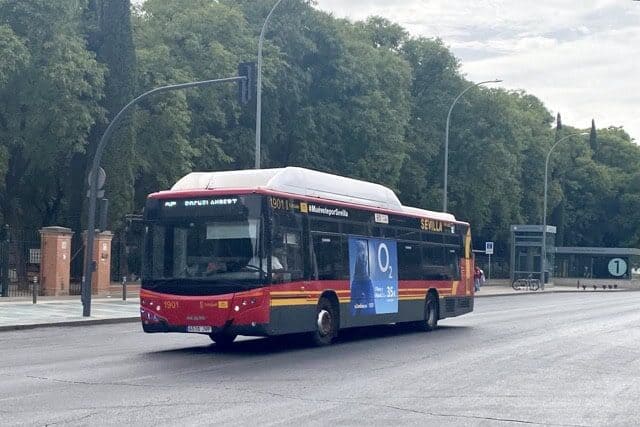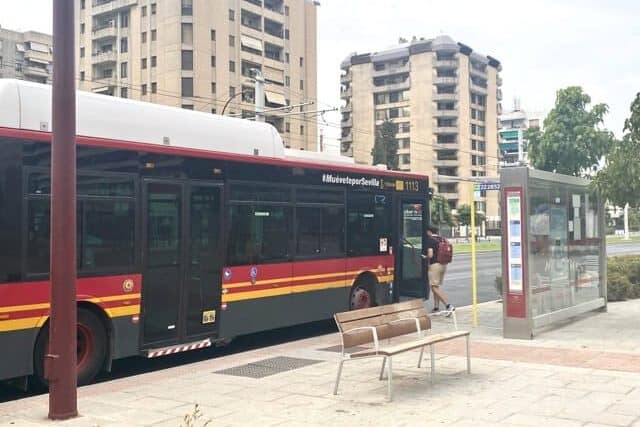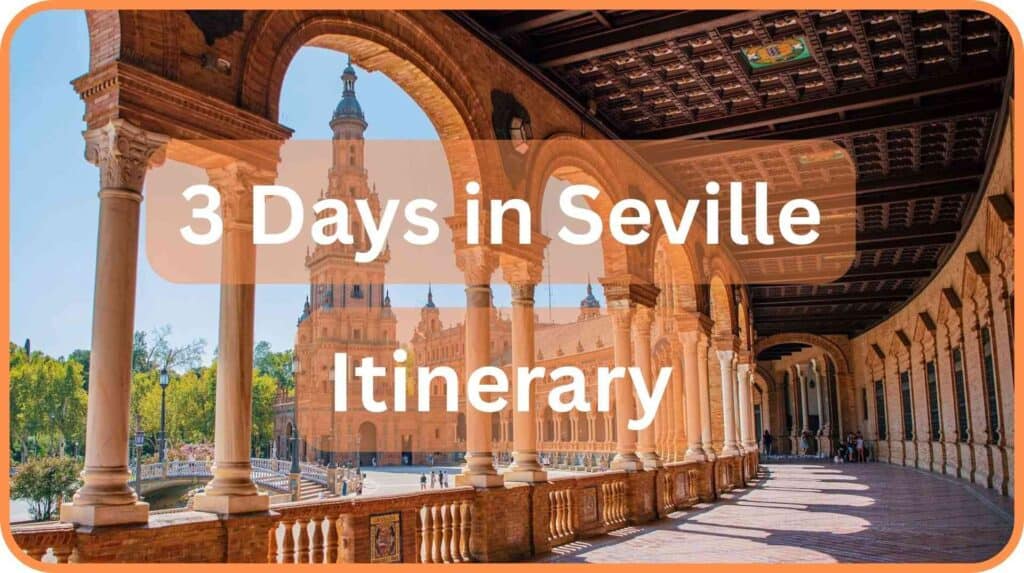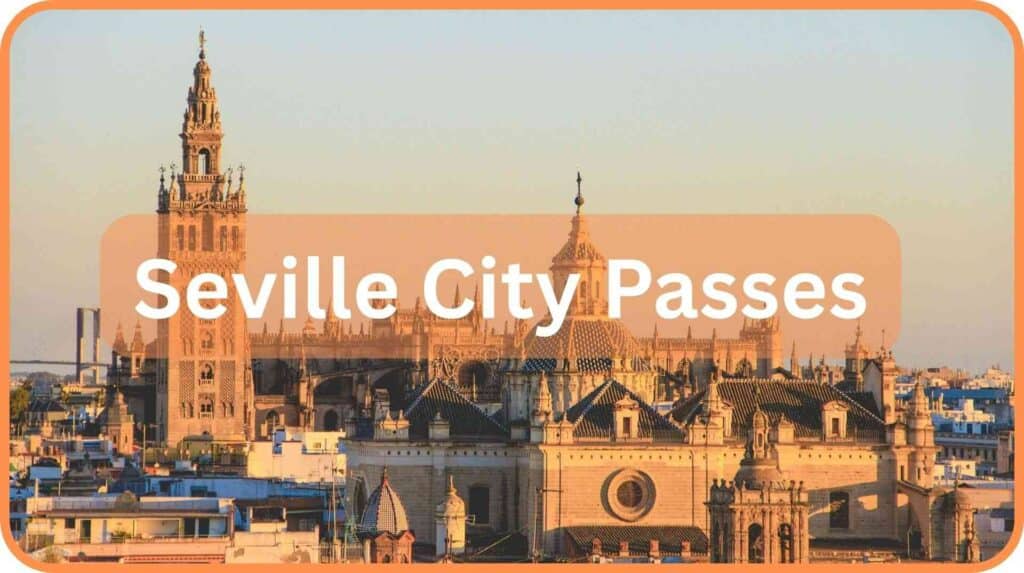Seville Itineraries
Disclaimer
Posts on visit-seville.com may contain affiliate links, meaning we get a small commission if you decide to make a purchase through our links, at no cost to you. Any income earned helps maintain this website and keeps it ad-free.
Seville Bus Guide 2025: Tickets and Using the Bus
Seville Bus – Stations and Ticket Guide


The Seville bus system is a practical and budget-friendly way to get around. With routes connecting Seville airport, main stations, and top attractions, buses make it easy to explore the city.
This guide covers everything you need to know about using Seville’s buses, from where to buy tickets to the key stations, routes, and airport connections.
Seville Bus – General Information |
|
Routes |
There are over 55 bus routes operating in Seville via TUSSAM. Check Seville bus routes online |
Times and Frequency |
Services typically run from around 06:00AM until midnight, though exact start and end times vary by route. |
Tickets and Prices |
A single bus ticket in Seville costs €1.40. The EA airport bus costs €6 one way. |
Overview of Seville Bus
Seville’s bus system is an essential part of public transport in the city, offering a practical and affordable way to get around for both locals and visitors.
The local buses are operated by TUSSAM, which runs more than 55 routes across Seville, connecting the historic centre, main neighbourhoods and attractions like the Cathedral, María Luisa Park, and even the airport.
For longer journeys beyond the city, long-distance buses operated by companies such as ALSA and Avanza connect Seville with other Spanish cities as well as international destinations like Portugal. The main hub for these services is Estación de Autobuses Plaza de Armas, located near the city centre.
You can book long-distance buses from Seville online to destinations such as Málaga, Córdoba or Granada.
Seville Bus Tickets: How to Buy
A single bus ticket in Seville costs €1.40. You can buy it directly from the driver using cash (exact change is recommended), or tap your debit or credit card on the machines inside the bus, which is often the faster option. The price is the same whichever method you choose.
If you are planning to take several TUSSAM buses and/or trams, you may want to consider the Tarjeta Turista, a tourist pass that allows unlimited travel. It is available as a one-day card (€5) or a three-day card (€10). A refundable deposit of €1.50 is added for the physical card, which you get back when you return it. The card is personal and cannot be shared, and the most central place to purchase it is at the TUSSAM Customer Service office near Prado de San Sebastián station.
If you are staying in Seville for longer, we recommend getting a Tarjeta Multiviaje as it’s the most economical choice. This rechargeable multi-trip card costs €1.50 for the plastic card, and once topped up, each journey is reduced to just €0.41. You can buy and recharge it at kiosks, tobacconists, and TUSSAM customer points around the city.
Seville Bus Routes
Seville’s bus network is extensive, but for tourists, only a handful of routes are especially useful. The most important are the C-line circular routes (C1, C2, C3, and C4), which loop around the city and stop near the main attractions. In addition, the Seville airport bus (EA) connects the airport with central Seville and key transport hubs.
Night buses (lines A1–A8) also run from Prado de San Sebastián, offering late-night connections across the city. They usually operate until around 02:00 AM from Sunday to Thursday (including bank holidays) and until 05:00 AM on Fridays, Saturdays and bank holidays eve.
The Circular C-Line Routes (C1, C2, C3, C4)
The C1 and C2 routes circle the outer ring of the city centre. They connect major transport hubs such as Santa Justa Train Station, San Bernardo, Prado de San Sebastián or Plaza de Armas, making them very handy for getting between train and bus stations. The C1 runs clockwise whereas C2 runs counter-clockwise.
The C3 and C4 routes circle the inner historic centre and are the most useful for sightseeing, with stops at Puerta de Jerez, Plaza de España, Prado de San Sebastián, San Bernardo or Cartuja. The C3 bus runs clockwise whereas the C4 runs counter-clockwise.
Seville Airport Bus (EA)
The EA (Especial Aeropuerto) bus is the easiest way to travel between Seville Airport and the city centre. It runs daily from around 04:30AM to 01:00AM, with departures every 15–30 minutes depending on the time of day.
The route has 11 stops, including Santa Justa Train Station and Prado de San Sebastián, before terminating at Plaza de Armas bus station. Tickets cost €6 one way or €8 return (same day) and can be purchased on board.
However, if you are travelling as a group of two or more, we normally recommend ordering an Uber or Cabify instead. These rides tend to cost around €15 to the airport, and in our experience they are far more comfortable as you’re guaranteed a seat, whereas on the bus you may end up standing for the entire journey.
Seville Bus Stations
Seville has two main bus stations for longer-distance travel:
Plaza de Armas Bus Station
Plaza de Armas is the main bus station in Seville for most national and international routes. From here you can catch long-distance buses to other major Spanish cities, such as Madrid, Barcelona or Valencia, as well as routes into Portugal (Lisbon, Faro, and the Algarve).
The station is located near the city centre, right next to the Guadalquivir River, and is well connected to the rest of Seville by local buses. You can easily reach it on the C1 or C2 circular routes, or directly from the airport using the EA bus.
Inside the terminal you’ll find ticket counters, waiting areas, shops, toilets, and cafés, and just across the road is the Plaza de Armas shopping centre. Even though there are ticket counters, we recommend booking tickets online, as in our experience staff often do not speak English and it saves time queuing.
Prado de San Sebastián Bus Station
Prado de San Sebastián is smaller but very useful for regional and provincial routes. This is where you’ll find buses to popular day-trip destinations around Andalusia.
The station is located next to Prado Gardens and close to María Luisa Park, making it one of the most central transport hubs in the city. It is served by the circular buses and by the tram line (MetroCentro T1), so it’s easy to connect from other parts of Seville.
Inside the station you will find ticket counters, waiting areas, snack and drinks kiosks, vending machine and toilets.
Useful Tips for Using Seville Buses
Over time living in Seville, we’ve picked up a few important things about using the Seville buses that can save you time, make your journeys smoother and help you avoid disappointment:
- Carry some coins: Almost all buses now have debit/credit card machines installed, especially on the popular C-line routes. If you are taking a less frequent or niche route, we still recommend carrying some coins just in case.
- Checking bus times: Many bus stops have digital screens showing the next arrival. If your stop doesn’t, you can use Google Maps or the official TUSSAM App by entering the stop number displayed on the shelter.
- Stops aren’t always announced: Not all buses announce the next stop. To avoid missing yours, keep an eye on Google Maps while on board so you know when you’re getting close. Remember to press the red “Stop” button in advance, as drivers don’t always stop if no passengers request it.
- Signal to the driver: If you are waiting at a bus stop and see your bus approaching, raise your arm or wave. Drivers may assume you are waiting for another route and pass by if you don’t signal.
- Accessibility: All Seville buses are equipped with wheelchair ramps, but many travellers find the tram more comfortable, spacious, and easier to use if you’re in a wheelchair or pushing a pram.
- Disruptions and diversions: Routes can occasionally be affected by construction work, traffic, or Seville local events. To avoid surprises, check the latest TUSSAM service alerts before you travel.
- Longer stops at Prado de San Sebastián: As Prado de San Sebastián is one of the city’s main transport hubs, buses often stop here for longer than usual. This is perfectly normal as sometimes drivers pause to realign with the timetable or to change shifts. Don’t worry, you don’t need to get off the bus.
Seville Hop on Hop Off Bus
As an alternative to regular TUSSAM buses, visitors can also use the Seville hop-on hop-off sightseeing buses. These are designed specifically for tourists as they stopping at the main landmarks.
They take the hassle out of planning routes, and tickets include onboard audio commentary (via headphones) in multiple languages so you can learn about Seville as you travel.
For more information about routes, tickets and prices, check out our Seville Hop-On Hop-Off Bus Guide.
Seville Bus: Frequently Asked Questions
Is there a bus from Seville Airport to the city centre?
Yes, there is a bus from Seville Airport called the EA bus (Especial Aeropuerto). This bus operates daily from around 04:30AM to 01:00AM, with tickets costing €6 one way or €8 return (same day).
Can I pay with card on Seville buses?
Yes, you can pay with card on most TUSSAM buses as they have machines on board for you to tap your debit or credit card. This costs the same as buying a single ticket (€1.40). However, if you’re taking a less frequent route, we recommend carrying some coins as a backup, since not every bus is equipped or the machines can occasionally be out of service.
More on Visit-Seville





